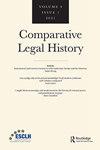编辑
IF 0.5
Q2 LAW
引用次数: 0
摘要
本刊邀请读者在不同的司法管辖区和时期探索法律。比较法律史作为一门学科,带领读者穿越时间和空间的轴线,激发自我意识和对他者的理解。欧洲比较法律史学会(ESCLH)自豪地提供了这个论坛,旨在促进对法律科学发展的研究,法律思想的流通,以及跨越时空的对话。第9卷第1期邀请读者重新审视现有的理解,通过新颖的视角看待法律和历史。本期的文章部分带领读者探索世界地图的不同部分,特别关注发生在中世纪和近代早期的事件。第一篇文章由塔玛尔·赫尔佐格(Tamar Herzog)撰写,架起了一座横跨大西洋的桥梁,重新审视了之前对习俗的理解。作者提供了丰富的叙事对话,指出欧洲和美洲的演员可以相互学习。第二篇文章由Paolo Astorri撰写,重点关注欧洲的发展对整个基督教世界的影响。笔者研究了天主教和路德教的学者以及法官的决策功能。对话、争议和不同的立场提醒读者,法律是一门社会(和动态)科学。第三篇文章是Kiran Chaudhuri写的,带读者去了日本。它着眼于刑法和刑事司法的发展,从中世纪到二十世纪。作者描绘了日本法律文化与他者性的对话,考察了法律思想跨大洲、跨世纪的传播。本期的三篇文章提醒读者,有些理解不应被视为毫无争议的教条。重新审视先前的理解确实有价值,而接触他者只会对比较法律史的学科发展有益。关于比较法律史的文献在不断发展。这是学者们在不同时间和空间研究法律的成果。此外,它还受到以比较法律史为主题的学术会议的出版物的培育。例如,ESCLH自2010年以来每两年举办一次会议,而近年来,比较法律史是第24届英国法律史会议和美国比较法学会2020年年会的主题。这些文献也随着研究资助的产出而增长,这些资助授予了致力于比较法律历史研究的学者。该杂志有助于引起人们对最近出版物的注意,并通过其书评部分评估它们在学科文献中的地位。第一篇书评涉及对加泰罗尼亚死刑的研究,介绍了事态发展本文章由计算机程序翻译,如有差异,请以英文原文为准。
Editorial
This journal invites readers to explore law in different jurisdictions and time periods. Comparative legal history–as a discipline–takes readers in journeys across the axes offered by time and space, triggering self-awareness and understanding of otherness, alike. The European Society for Comparative Legal History (ESCLH) takes pride in offering this forum, aiming to foster the study of the development of legal science, the circulation of legal ideas, and the dialogue that takes place across time and space. Issue 1 of Volume 9 invites readers to revisit existing understandings, looking at law and history through novel perspectives. The articles section of this issue takes readers to explore different parts of the mappa mundi, with special attention on events that took place during the Middle Ages and early modern period. The first article, by Tamar Herzog, lays a bridge across the Atlantic Ocean, revisiting the prior understanding of customs. The author offers an enriching dialogue between narratives, noting that actors in Europe and the Americas can learn from each other. The second article, by Paolo Astorri, focusses on European developments that had an impact across the Christian world. The author studies Catholic and Lutheran scholars and the decision-making function of judges. Dialogues, disputes, and different positions remind readers that law is a social (and dynamic) science. The third article, by Kiran Chaudhuri, takes readers to Japan. It looks at developments in criminal law and criminal justice, crossing from the Middle Ages until the twentieth century. The author depicts the dialogue of Japanese legal culture with otherness, looking at the circulation of legal ideas across continents and centuries. The three articles in this issue alert readers that some understandings are not to be considered uncontested dogmas. There is indeed value in revisiting prior understandings, while exposure to otherness can only be beneficial for the disciplinary growth of comparative legal history. The literature on comparative legal history continues to develop. It is the result of the work of scholars who look at the law in different times and spaces. Further, it is nurtured by the publications that derive from academic meetings that take comparative legal history as their main theme. For example, the ESCLH organizes biennial conferences since 2010, while in recent years comparative legal history was the topic of the XXIVth British Legal History Conference and of the 2020 Annual Meeting of the American Society of Comparative Law. The literature also grows as the output of research grants awarded to scholars that devote their efforts to comparative legal historical research. This journal helps to draw attention to recent publications and evaluate their place within the disciplinary literature particularly through its book reviews section. The first book review deals with a study of death penalty in Catalonia, placing developments
求助全文
通过发布文献求助,成功后即可免费获取论文全文。
去求助
来源期刊
CiteScore
1.70
自引率
0.00%
发文量
20
期刊介绍:
Comparative Legal History is an international and comparative review of law and history. Articles will explore both ''internal'' legal history (doctrinal and disciplinary developments in the law) and ''external'' legal history (legal ideas and institutions in wider contexts). Rooted in the complexity of the various Western legal traditions worldwide, the journal will also investigate other laws and customs from around the globe. Comparisons may be either temporal or geographical and both legal and other law-like normative traditions will be considered. Scholarship on comparative and trans-national historiography, including trans-disciplinary approaches, is particularly welcome.

 求助内容:
求助内容: 应助结果提醒方式:
应助结果提醒方式:


